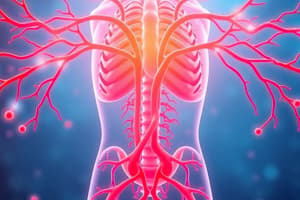Podcast
Questions and Answers
Where do the interruptions (synapses) between the CNS and the receptor sites occur in both the parasympathetic and sympathetic divisions of the ANS?
Where do the interruptions (synapses) between the CNS and the receptor sites occur in both the parasympathetic and sympathetic divisions of the ANS?
- Spinal cord
- Autonomic ganglia (correct)
- Brainstem
- Peripheral nerves
In which division of the ANS are the preganglionic neurons very long and the postganglionic neurons short?
In which division of the ANS are the preganglionic neurons very long and the postganglionic neurons short?
- Sympathetic division
- Somatic nervous system
- Parasympathetic division (correct)
- Peripheral nervous system
From which segments of the spinal cord does the sympathetic division branch off the CNS?
From which segments of the spinal cord does the sympathetic division branch off the CNS?
- Lumbar and sacral segments
- Cervical and sacral segments
- Cervical and thoracic segments
- Thoracic and lumbar segments (correct)
Which part of the body does the parasympathetic division branch off the CNS through?
Which part of the body does the parasympathetic division branch off the CNS through?
Flashcards are hidden until you start studying
Study Notes
Interruptions and Synapses in ANS
- Interruption points, known as synapses, occur between the central nervous system (CNS) and receptor sites in both sympathetic and parasympathetic divisions of the autonomic nervous system (ANS).
- In the parasympathetic division, synapses typically occur close to or within the target organs.
- In the sympathetic division, synapses are located in ganglia that are positioned near the spinal cord, away from target organs.
Preganglionic and Postganglionic Neuron Lengths
- In the parasympathetic division of the ANS, preganglionic neurons are very long, allowing them to extend directly to or near the target organs.
- The postganglionic neurons in the parasympathetic division are short, as they originate near the target organs.
Sympathetic Division and Spinal Cord Segments
- The sympathetic division branches off the CNS from the thoracolumbar regions of the spinal cord, specifically from T1 to L2 segments.
- This connection establishes a close relationship between sympathetic activity and spinal reflexes.
Parasympathetic Division Origin
- The parasympathetic division branches off the CNS primarily through cranial nerves and sacral spinal nerves.
- Major cranial nerves involved include the oculomotor, facial, glossopharyngeal, and vagus nerves, along with sacral nerves S2 to S4.
Studying That Suits You
Use AI to generate personalized quizzes and flashcards to suit your learning preferences.




